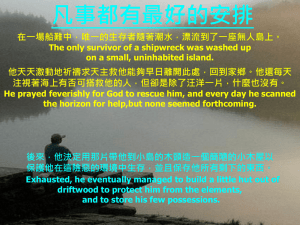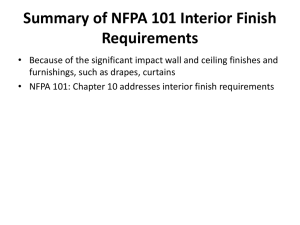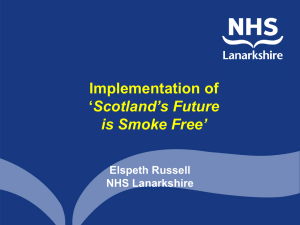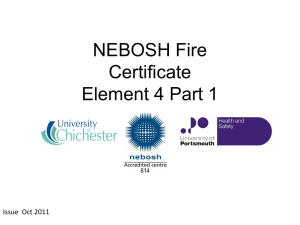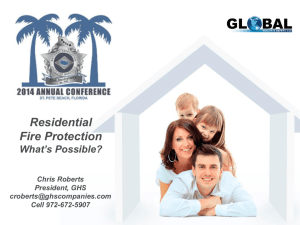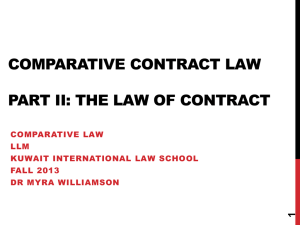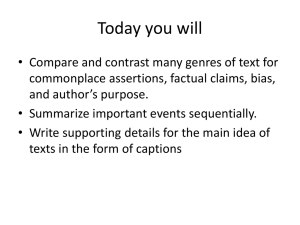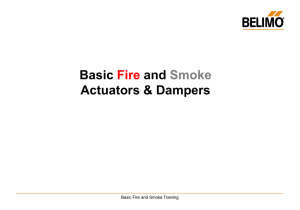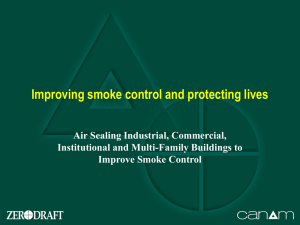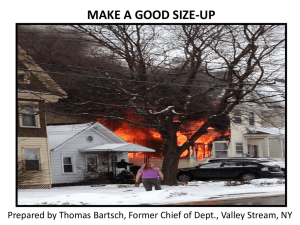PowerPoint: Firefighter I and II Re
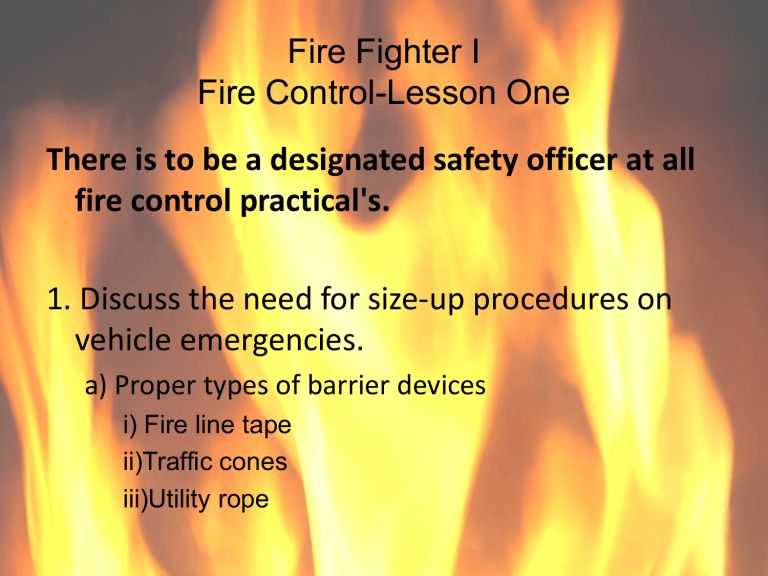
Fire Fighter I
Fire Control-Lesson One
There is to be a designated safety officer at all fire control practical's.
1. Discuss the need for size-up procedures on vehicle emergencies.
a) Proper types of barrier devices i) Fire line tape ii)Traffic cones iii)Utility rope
Fire Fighter II
Building Construction
Lesson Three
TERMINAL OBJECTIVE
The Firefighter II candidate shall correctly define in writing the different material used in lightweight construction as well as identify lightweight construction components, describe their reaction to fire and truss locations found in structures.
ENABLING OBJECTIVES
1. The Firefighter II candidate shall identify in writing, what is considered lightweight construction and the materials used in the components of lightweight construction.
2. The Firefighter II candidate shall describe in writing, the reaction of lightweight structural components to fire.
3. The Firefighter II candidate shall identify in writing, the locations where trusses can be found in structures.
Fire Fighter II
Building Construction
Lesson Three
ENABLING OBJECTIVE#1
The Firefighter II candidate shall identify in writing, what is considered lightweight construction and the materials used in the components of lightweight construction.
1. Define the term “Truss construction.”
2. Discuss “surface to mass ratio.”
3. Discuss “Open web steel joists.”
4. Discuss “Wood trusses.”
5. Point out the different types of trusses.
6. Label the different parts of a truss.
Fire Fighter II
Building Construction
Lesson Three
7.
Point out the difference between a steel truss and a wood truss.
8.
Discuss the function of gusset plates to wooden trusses.
9.
Define the term “Engineered wood structural member.”
10. Define the term “Plywood.”
11. Define the term “Oriented Strand Board.”
12. Discuss compression and tension forces as it relates to truss construction.
Fire Fighter II
Building Construction
Lesson Three
ENABLING OBJECTIVE#2
The Firefighter II candidate shall describe in writing, the reaction of lightweight structural components to fire.
1. Discuss the statement – “Our trusses are engineered.”
2. Discuss hazards associated with a “truss void.”
3. Discuss the fire characteristics of steel trusses.
4. Discuss the fire characteristics of wood trusses.
5. Discuss the fire characteristics of wooden I beams.
Fire Fighter II
Building Construction
Lesson Three
ENABLING OBJECTIVE# 3
1. The Firefighter II candidate shall identify in writing, the locations where trusses can be found in structures.
2. Discuss floor trusses and the problems associated with them.
3. Discuss roof trusses and the problems associated with them.
Fire Fighter II
Fire Behavior
Lesson Two
ENABLING OBJECTIVE #3
The Fire Fighter II candidate shall correctly describe in writing why recognizing observations in reading smoke and the warning signs of hostile fire events is important.
1. Explain why reading smoke is important to evaluating the fires position within a building.
2. Explain how evaluating the volume of smoke assists in the understanding of the amount of fuel that is off-gassing in a given space.
3. Explain that the velocity of smoke is an indicator of pressure.
4. Describe the two things that can create smoke pressure.
a. Heat b. Restricting the volume of smoke within a container
Fire Fighter II
Fire Behavior
Lesson Two
5. Explain how smoke thickens.
6. Discuss the fact that the greater the smoke density, the more likely a hostile fire event can occur.
7. Explain that the color of smoke will only indicate the type of burning material in a single-fuel fire.
8. Point out that smoke can tell the Fire Fighter which stage of burning is taking place.
APPLICATION
Divide the class up into suitable size work groups 3-5 candidates. Show them pictures of different fire scenarios and have them evaluate the smoke conditions. Assist them in recognizing the volume, velocity, density, and color of smoke for each picture.
Reading Smoke
Why “Read” Smoke?
To determine “ HOW MUCH ” fire
Why “Read” Smoke?
To help find the LOCATION of the fire
Why “Read”
Smoke?
To help predict
COLLAPSE potential
Why “Read” Smoke?
To help PRIORITIZE Strategies & Tactics
Why “Read” Smoke?
To PROTECT Firefighters from a
“ HOSTILE FIRE EVENT”
Flashover
Back Draft
Smoke Explosion
Auto Ignition
Rapid Fire Spread
The “ADVANCED” Basics
What is “Smoke”?
Aerosols
Gases
Particles
Carbon
Dust
Other fibers
Solid Particles
Hydrocarbons
• Oil
• Tar
Aerosols
Fire Gases
• Carbon Monoxide
• Hydrogen Cyanide
• Acrolein
• Hydrogen Sulfide
• Benzene
Smoke is FUEL!!!
Additional Products of Combustion:
•Water Vapor
•Unburned Particles
•Carbon Dioxide
Flashpoint and Auto Ignition
Temperatures
• Carbon Monoxide -
• Hydrogen Cyanide 0 F
• Acrolein
• Hydrogen Sulfide
• Benzene
-15 F
-
1292 F
428 F
12 F 928 F
538 F
500 F
Hydrogen Cyanide
Hydrogen Cyanide is more prevalent now than ever before due to the increased use of synthetics.
It attacks our bodies through Oral inhalation as well as Occular and Dermal absorption .
It is more lethal than CO and is more difficult to test for toxicity levels.
It is suspected of contibuting to the many of the FF Fatalities in the past originally thought to CO induced.
LAYERS
Fuel – UEL and LEL
Reaction - Oxygen-Fuel effect
Ceiling layer-
High fuel/Low Oxygen
Floor Layer-
High Oxygen/Low Fuel
They meet at the reaction layer
Oxygen – Deficient or Enriched
The “ADVANCED” Basics
What relationship does mass & density have on fuels?
Fuels are Synthetic now
Fuels have LESS MASS – they off-gas quicker!
Building Construction Factors
Construction
Contents
Size
Ventilation
Fire protection systems
Type
Insulation
Condition
Heat Flux
Construction
Lightweight Construction
• I-Joist
Lightweight Construction
• Glu-Lam
• Finger-Joint
Lightweight Construction
• Panels
Lightweight Construction
• Wood Truss
Gusset Plates
How Wood Burns
• As the surface temperature of wood increases due to fire exposure, flammable vapors are produced and a char layer
(burnt wood) is formed on the external surfaces.
• In the presence of fire, these flammable vapors ignite and contribute to the fire.
• As the char layer gets thicker, it insulates the remaining unburned wood and slows the rate of vapor production, thereby slowing the charring process
http://www.sbcindustry.com/configurations.php
Links
• American Forest & Paper Associationhttp://www.woodaware.info/index.html
• Southern Building Components Association
• http://www.sbcindustry.com/configurations.php
Type of fuel load
Contents
Size / Amount
Construction and Contents
Homeowners “padding” their homes:
Plusher carpet
Elaborate curtain & drapes
More / heavier furniture
Comfort accessories
“Bed, Bath & Beyond”
Increasing use of synthetic materials
Tighter construction
Better insulation
Modern construction materials
Double/triple pane EE windows
Area
Height
Configuration
Size
Ventilation
Volume
Distance
Type
Influences fire spread
HVAC
Fire Protection Systems
Sprinklers
Standpipes
“Modern” Structure Fire
Ceiling temps have increased from 1300 to
1600 degrees
BTU production > 18,000
(more than doubled)
What Does this Mean For Us?
• Doesn’t necessarily change our tactics…
• Does accelerate our tactical time frame at an incident...
The “ADVANCED” Basics
• How does “flammable range” factor in?
Flammable Range & the Three Fires
Too Rich . . .
Too Lean . . .
Just Right . . .
The “ADVANCED” Basics
To Read Smoke – you must be able to:
1. Determine the stage of burning (early, growing, late)
2. Tell if the Fire is in Thermal Balance (smoke up and out, fresh air in).
3.
Find out if the “box” is absorbing heat or not
(Linear vs. Turbulent Smoke Flow)
“ HOSTILE ”Fire Events
• Flashover
• Back draft
• Smoke Explosion
• Rapid Fire Spread
• Auto Ignition
FLASHOVER
Fuel mass/box is heat saturated
Reflective radiant heat intensifies
Simultaneous ignition of fuels
Warning Signs: Turbulent smoke, Rollover, Auto-Ignition
Flashover of one box means what?
Flashover
Transition or event that occurs between the incipient and fully developed phases of fire
All surfaces that are exposed ignite at once
BACKDRAFT
Introduction of oxygen to an environment that is:
Heated past fuel ignition temps
Usually confined or restricted
Pressurized with gases
Capable of sustained burning
Warning Signs: Ugly Yellow/grey smoke, Smoke leaving cracks under pressure, black-stained windows
Note: Puffing is NOT a good warning sign( a pressurized container must vent before it can suck!)
SMOKE EXPLOSION
A pocket of gas that has reached an ignitable mixture but not enough energy to sustain ignition
Ignition of this pocket is a spark or flame – which then causes an “explosive” surge of pressure
Usually no resulting fire - but increased chance of fire spread (container breach?)
Ceiling spaces and vaulted ceilings are candidates for smoke explosions
RAPID Fire Spread
Usually “Container” Influenced – especially stairs and hallways
Fuel is continuous and available to burn
Especially “volatile” fuel causes the spread – usually smoke-cloud ignition
Thermal Balance exists
Usually results from another “event”
AUTO IGNITION
Typically used to describe the ignition of fuels AFTER they leave the box
Primarily a WARNING SIGN
Exposure Threat:
Other parts of building
Other Buildings
Firefighters
“ Reading Smoke”
Observations are typically made from outside - inside observations hide the “real” picture.
Outside
• IC
• Safety
• RIT
• Backup
Size Up
Inside
• Fire attack crews
• SAR crews
• Salvage crews
Before you “ Read Smoke”
RULES:
Nothing is absolute
Visible FIRE is easy to read - look past it for the real story
Compare all Openings/Cracks
The ART of Reading Smoke
A 4-STEP
PROCESS to help predict fire behavior and hostile events
Step 1: Evaluate
Key Factors
Volume = Fullness of Box
Velocity (Pressure) = Heat,
Volume, and Distance to fire
Density = Quality of burning
– likelihood of “event”
Color = Stage of Heating,
Distance, amount of
“flaming”
Characteristics of Smoke
Velocity
Color
Volume
Density
Air Track
Smoke Velocity
May be an indicator of pressure inside the container
Pressure may be caused by heat or volume
Smoke Velocity
If the velocity or pressure is a result of heat, the smoke will rise and loose velocity.
If the velocity or pressure is a result of volume, the smoke will loose velocity but also maintain a neutral buoyancy.
Smoke Velocity
• Turbulent smoke is a potential indicator of the container not being able to absorb more heat.
• Laminar smoke is a potential indicator of the container still being able to absorb heat.
Smoke Velocity
• Smoke will become slower as distance from the seat of the fire increases.
• To locate the seat of the fire, compare smoke coming from several opening and determine which has the most turbulent smoke coming from the smallest opening
Smoke Color
Heavy/light is an insufficient description
The department should have predetermined descriptions of smoke conditions in place in SOP’s
Darker-
White-
Grey/yellow-
Brown-
Smoke Color
Hydrocarbon fuels
Incipient fire or great distance from the seat
Ordinary combustibles
Wood at or near ignition temperature possibly involving structural components
Smoke Color
Light colored smoke may have large amounts of unburned fuel and may have travel some distance picking up moisture and depositing carbon.
Dark smoke often indicates an under ventilated fire or hydrocarbon fuels.
Smoke Volume
May relate to amount of fuel
May relate to pressure
Best as an indicator when coupled with other indicators
Ventilation controlled fires that near the smoldering stage may produce larger quantities of smoke.
Indicator of degree or location of fire.
Smoke Density
May result from amount of fuel in the smoke
Heavy/light description is inadequate
Optical Density
Refers to how well you can see through the smoke.
Optically dense smoke may contain high concentrations of particulate matter.
Often described as having the appearance of velvet.
Relates to the fuel and degree of ventilation.
Physical Density
Refers to the buoyancy of the smoke.
The higher the higher the density, the lower the temperature and pressure, the smoke sinks.
The lower the density, the higher the temperature and pressure, the smoke will rise.
Pay Attention to Changes
Any significant change over a 5 second period may indicate a hostile fire event or loss of structural integrity.
Pay Attention to Changes
Sudden rise in hot gas layer
• Ventilation from outside crews
• Self ventilation
Pay Attention to Changes
Sudden lowering of the hot gas layer
Worsening condition
• Impending flashover
• Rapid fire progression
Water application
• Excessive
• Inappropriate
Not typically visible
Heat
Must observe its effects
Air Track
Direction of smoke
Direction of fresh air
Direction of Smoke
Heated gases will move up and out from the fire
Often predicts the path of fire spread
Pay attention to the height of the hot gas layer (Thickness)
Tricks
When making entry-look at the direction of the smoke and the fresh air.
Always carry a light and observe the direction of the smoke and the fresh air.
Size of opening
Temperature
• Laminar
• Turbulent
Air Track
Air Track
Neutral plane
• Charles’ law: as the temperature of a gas increases it will expand becoming less dense and more buoyant
• Gay-Lussac’s law: when the volume of gas remains constant and the temperature increases, pressure increases
Movement of the hot gas layer
• Up or down
Air Track
Neutral Plane
• The plane that is formed between the hot air layer (top) and the cool air or oxygen layer (Bottom).
• The hot air layer typically moves outward away from the seat of the fire and towards the ventilation point.
• The cool air typically moves inward towards the seat of the fire.
Neutral Plane
Visible Flames
Most obvious indicator
Often the latest indicator to develop
High V.V.D.C. =
“BLACK FIRE”
“Black Fire” is the term we give to High Volume,
High Velocity, Extremely
Dense, Black Smoke.
It is the sure sign of impending flashover –
VENT & COOL are your only choices.
Black Fire
Is there a chance of survival in a compartment that is producing black turbulent smoke?
Are rescue efforts feasible?
160 Degrees
The maximum survivable (wet) temperature
Step 2: Weigh
Factors
Container (most important factor)
Thermal Balance
Weather
Firefighting efforts
Other factors?
Step 3: Judge the Fire Status
Are conditions getting better or worse?
Classify the Fire: Stable -predictable
Unstable/Unpredictable
Rapidly changing
-predictable
Step 4: Predict the EVENT
Consider that:
One hostile event can and usually will lead to another event.
Communicate your observations.
Warning Signs are not always visual – use your KNOWLEDGE and EXPERIENCE.
TRUST YOUR INSTINCTS…
Some other “Tricks”
When you open a door or window - watch what the smoke does…and what THE
FRESH AIR DOES!
Some other
“Tricks”
In poor visibility - watch the smoke in front of your light - it will give you some clues
Some other “Tricks”
A 5-second change in any key factor means an event has taken place – the key is to define what event has taken place and to forecast what will likely happen next .
“The garbage man doesn’t get excited when he turns the corner and sees trash, and you shouldn’t get excited when you turn the corner and see fire.”
“You should expect fire on every run.”
-Lt A. Fredericks
Special Thanks to
David Dodson
With less fires - this ART could be lost… take the lesson… pass it on.
David Dodson
